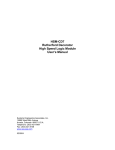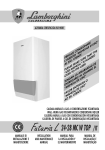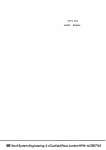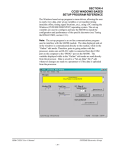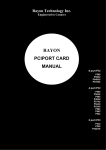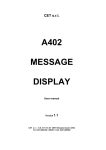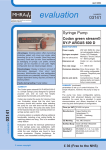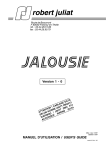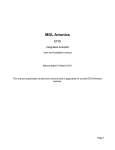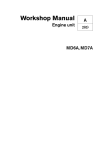Download JB 2090 User Manual
Transcript
JB 2090 User Manual Unpacking The Cigarette Smoking Machines (CSM) are delivered in one single wood case. The front panel marked « Open this panel » is also ramp. A few “Torks” screws must be removed first. The machine is maintained in its transport case by a transverse beam locking the base plate. This beam is the next item to be removed. The machine can then be rolled out as shown below. It is advisable that two persons do this to ensure a safe rollout. Accessories will be found in the parcel attached on the base plate. The twin P4T pump assembly in a tray on right has to be installed on the left side of the CSM. The machine is transported on a 2” expanded polystyrene floor planned to act as a damper in case of shocks during transportation. It is recommended to check that the machine and in particular the stainless steel base plate do not show signs of damage due to vertical shocks (heave). Note the small toolbox visible at rear of box on the picture above. 1 The cover of the toolbox shown below contains usually two identical keys for the electrical cabinet, a pusher for short cigarettes, a spare ash spring and 3 cigarette holders. There may be more items upon request. The lower compartment of the toolbox shown below contains two sets of Allen keys and a torks screw for the ashtray drive motor. 2 Once rolled out, remove floor panel in box. The carousel is stored in a recess well protected from any damage, which may occur during transport. We recommend keeping the transport case in good storage condition in the event of having to ship the machine again on a later occasion. 3 Setup Product identification Each JB 2090 is identified with the use of a profile number. This Number is located inside the swiveling front panel under the touchscreen on a black sticker. Please indicate this reference number whenever ordering spare parts. Electrical connections All electrical connections to the product must be rated according to the Requirements for circuits as defined in EN-Standards. The CSM accepts a variety of input voltages. A selector located inside the electrical cabinet must be set to the particular voltage. The CSM is shipped with the voltage selector set on 110V 60 Hz. The machine is supplied with a standard 3-pole US Power cord located at the rear. The main switch is on the right side of the machine. The CSM meets EC Safety standards. General Layout The CSM is composed of two main units stacked: the smoking machine and, below, the electrical cabinet. The smoking machine groups all mechanical components which are necessary to automatically smoke cigarettes in restricted smoking condition according to ISO 3308 standard. A front panel contains an interactive touch-screen for inputs. Minimal electric components are mounted inside the CSM, in particular the power source for the electrical lighter. For safety reasons the front panel is equipped with a lock. 86 psi air and propane (or butane) gas are directly supplied to the smoking machine. A gas lighter is an option. The programmable control module is located in a cabinet containing electrical and electronic hardware. The assembly is on a base frame, it has 4 rolls all can be locked. Care recommendations Manipulation of the spring on the butt length sensor should be carried out with care. It is a 0.1mm spring steel blade. This spring will break too 4 long ash rods off the cigarettes. Inadvertently hitting it will damage or destroy it. The carousel and the ISO flange are both in tempered stainless steel, a material currently used for cutlery, quite immune to scratches. The ISO flange is coated with an extremely hard (1500 Hv) wear resistant coating. This favors low friction and, being non-adhesive, ease of cleaning. The annular sealing surfaces must stay in perfect condition and the 30 smoke ducts must have sharp edges. A dent will break the seal and turn the smoking session invalid. Exceptionally metallic objects, ie a hexagonal screwdriver can be introduced in the smoke ducts with extreme care. Never put the bare carrousel with the sealing surface on a table. Leaving the cigarette holders on the carrousel will ensure a sufficient clearance to protect the sealing surface. Installing The CSM is serviced from the front. The PVC hood can be raised for access to the carrousel, lighters and sensors. Limited access must remain possible from the right side where the waste bowl is located. The door of the electrical cabinet must remain accessible as well. At the rear of the machine there is an exhaust air duct connection 100mm OD. This will be permanently connected to a ventilation network. The volume flow should attain 120 m3/h (70 cuft/mn). It is recommended to design the exhaust system with ample margin for about 200 m3/h. A compressed air line is necessary. Recommended pressure is 6 bar (86 psi). The connection to the machine is located at the rear on the pressure governor. The connection will accept OD 6 mm tubing. A suitable material is Polyurethane tubing. The connectors on the pneumatic valve group and actuators are quick connector, no tools are required. The clean-cut tube end just has to be pushed into the connector. To remove, press the blue plastic ring on the fitting connector while pulling the tube. The quick connector can be replaced for other tube diameters. Do not use wrenches or clamps on the outer diameter. It is recommended to use the most practical inner hexagon with an Allen key. Whenever gas lighting is used, a specific gas tube has to be connected on the 8mm OD burner tube, this is then laid around outside the ashtray fence towards the rear and out through the small window towards the right behind the waste bowl. Usually a hand gas valve is nearby. Propane and butane can be used indifferently. On the electrical cabinet, except for a mains switch, there are no controls for the operator. 5 Fittings below the ISO-flange There are several smoke ports on the periphery of the ISO flange allowing to smoke 1, 2 or 3 puffs during one turn of the carousel. The main puff port necessary for lighting is facing the electrical lighter. Under the ISO-flange the CSM the machine is supplied with a straight tube connector. This connector has a R 1/8” male thread to match the port in the flange. This fitting will accept 8mm OD tubing, preferably PTFE. It is a quick disconnect fitting. No tools are required to insert or remove a tube. Simply press the front blue ring to unlock the clamping system. The supplied make is a stainless steel “Festo” make but any other equivalent straight or elbow fitting can be installed. The fittings usually have an outer hexagon suggesting the use of a fork key. We do not recommend the use of such tools mainly because the access is generally too obstructed. JB 2090 machines are supplied with 2 P4T pumps. Pump 1 is connected to the main puff port. The second pump is connected to port at the 180 degree location, opposite from main port (half-turn). 6 It is by far advisable to use Allen keys considering that most good fittings have an internal hexagon. Fig. 4 below shows an Allen key inserted in a Legris straight fitting. Some sizes are only accessible on the threaded side, not through going. Fig 5 shows how the fitting is tightened (or loosened) from above. Another advantage of the procedure is that prior to inserting the thread the Allen Key will line up the fitting with its thread. Therefore we also recommend favoring only fittings with an internal hexagon when purchasing a different model. 7 Smoke ducts We recommend using PTFE or PU tubing. The smoke tubes can be lead out of the machine in several ways: Through the base towards the P4T pumps Above the ashtray by using an elbow coupling To the rear through the removable aluminum plate closing off the rear of the base Compressed air Compressed dry (not lubricated) air is required to operate the hopper loader, the gas burner pivoting arm and to eject butts. Supply pressure to the laboratory should be about 6 bar (86 psi); a pressure governor near the CSM is advisable for pressure adjustment by the operator. The rotary and linear pistons are fitted with flow restrictors on the in and out lines. The restrictors can be set so as to easily obtain the desired speed of motion. Tools The toolbox mentioned previously contains hexagonal keys and hexagonal screwdrivers. The major sizes are indicated below. 8 Machine operation Hopper/Feeder It is good practice to check first the alignment of the hopper spoon with the cigarette holders. The first step is initializing the carousel so that it stops facing the hopper. The spoon is pushed manually forward so the cigarette can be positioned only millimeters ahead of the labyrinth seals and the alignment checked. The picture below shows the test. Note that the head is preferably rotated so that the large holes provide access to the four M6 screws locking the ISO flange to the base. By tightening the screws in a suitable order it is possible to finalize the perfect height adjustment of cigarette and holders. The cigarettes are stored in a hopper with a capacity of 400 standard cigarettes (dia 8m length 100mm). The hopper accepts cigarette lengths from 50 to 100mm. Loading stroke is adjusted manually to cigarette length. The loading piston is a double acting FESTO piston. The speed of the piston can be adjusted with the flow control valves at both ends of the piston. Rocking devices in the funnel avoid bridging by their reciprocating motion. The hopper case is designed for cigarettes up to 32mm circumference. 1mm aluminum shims are provided to smoke the more usual 25 mm circumference cigarettes. They fit in the funnel. Without shims, the 25mm circumference cigarettes will jam the funnel. The hopper spoon sitting on the pneumatic feeder is designed for 25mm circumference cigarettes and 80 to 100mm length. For other diameters and lengths below 80mm, specific spoons are provided. 9 After filling with cigarettes, the acrylic window can be introduced. It is first used to push and align the cigarettes, and then hooked on the appropriate notches allowing for a minimal clearance to the cigarettes. As it is difficult to align the notches on both sides of the hopper, marks are made every 2.5 mm as a reference. Adjustable steel plates on each side allow a quick replacement of the PMMA window at its usual position. Cigarettes are loaded into each holder of the rotating head by a pneumatic feeder. It carries the hopper spoon and a pusher to be adjusted with a screw. The setting of this screw should remain steady over time in spite of repeated actuations. Therefore the screw has an internal brake. The correct pusher setting has to be carried out with the Acrylic window in place with a minimal clearance left for the cigarettes, typically 1mm. Some test strokes are required to adjust the correct depth of introduction. It is recommended to set the pusher screw to the point the cigarettes are pushed a bit too firmly. Compression folds will show on the wrap paper. The pusher screw is then released up to the point where the cigarettes load unharmed. The machines supplied have been tested with cigarettes, which differ almost certainly from the test cigarettes. The first load tests with the particular cigarettes used in a new experiment may not be satisfactory. It will be necessary for the operator to spend some time for all adjustments. First in terms of length, suitable labyrinth seals, and hopper speed to obtain a very even loading of all holders. Also setting the lighter for best ignition will take some time. Later adjusting the ejection ghust so that the butt is ejected without fault. Loading can be carried out irrelevant of head movement. Loading is triggered by an angular sensor and software. Rotating head The rotating head – or carousel- supplied with the machine has 30 evenly distributed holders. The holders comply with ISO standard. The resulting distance between the centers of adjacent burning zones is less than 50mm against ISO 3308 (5.3.5). Loading the head with 15 cigarettes only will however comply with this particular ISO requirement whenever it is mandatory. The rotating head is supported by an annular self lubricating seal (the ISO Flange) with 8 ports, 6 of which can be used to draw smoke, one for enhanced lighting, one being the pneumatic butt ejection port. The sealing annular surfaces are to be taken care of, never use metallic tools to clean. The rotating head is driven by a MAXON servomotor and zero backlash gear. Rotation can be set manually to either continuous at constant speed, 1 rpm, or intermittent steps from port to port, or some ports skipped, and one full rotation. Automatic operation is 10 programmable to accept a wide variety of puff patterns. Maximum speed is 60 rpm to allow fast skipping wherever necessary. Rotation is in clockwise direction seen from above the machine. No tools are required to remove or mount the rotating head. Just lift it off. With reference to the motor drive, there is only one possible angular position fitting on the drive coupling. Optional items are ie. A rotary head with less ports or a special ISOflange for free smoking. Against common designs rotary head and ashtray are fully independent items leaving about 20mm circular free access directly under the rotary head. Smoke ducts can be drawn out for analysis work very close to the cigarettes. ISO Flange The rotating head turns over a fixed flange, the ISO flange. This flange has puffing ports at 0°, 84, 120°, 180°, 240°, 264°, 276°, 348°. The port located at 276° is used for pneumatic butt ejection. The 348° or -12° is for pre-ignition where new smoking materials need a substantially larger puff to ignite the cigarette. The angles are counted in clockwise direction, 0° being at the front closest to the operator. The rotating head and the ISO-Flange are tempered stainless steel. No particular lubrication is required unless sticky tobacco condensate remainders increase friction. All connectors to ports are female R 1/8” threads. The recommended connectors are straight or 90° fittings for 4 to 8 mm OD polyurethane or PTFE tubing. With the straight connector, a tube can be led out of the case below the ashtray to the rear. With 90° connectors a more direct path would lead above the ashtray to the sides of the machine, where analysis equipment, traps etc can be located. In both cases the length of tubing from the cigarette end to a point outside of the machine is about 0.5 meters. There is a large opening below the ISO flange allowing access to the numerous ports. Once the setup is defined and routine work is underway, it is advisable to close this opening avoiding residues falling into the machine base. Upon request a closure is provided. It consists of two halves in PVC, which can be easily modified to leave passages for piping or wiring required in the experiment. The picture below shows the available design. 11 Pressure drop It is assumed that a standard puff (35 cc/2 sec) flows in a 4 mm ID tube, 0.5 meters long. The velocity in the tube is 1.4 m/s. The pressure drop is 26 N/m2, well below the maximum limit in ISO 3308, 300 N/m2. Cigarette holders The anodized holders are screwed on the carrousel. The 5mm bore smoke duct has an internal 5 mm hexagonal section. This allows easy mounting and removing the parts with a 5mm Allen key. Never use tools grabbing the outer diameter of the holders. 12 Cigarette holder caps The Polypropylen PP holder caps are designed to receive color coded labyrinth seals and washers to ISO. There must be 4 labyrinth seals in the holder. The three first seals receiving the cigarettes have the cup facing the cigarette. The last labyrinth is flipped as shown below. The PP caps are light grey. This is to avoid confusion with white caps used on previous machines which were in POM. Once inserted in the holder the visible labyrinth must be as below. Holder caps are available in two lengths: 19.5mm standard and 28.5, optional, which cover vent holes of cigarettes. Ejection The butts are ejected pneumatically. The ghust can be adjusted with a flow restrictor located next to the hopper. The flow direction is marked on the restrictor. Erroneous mounting will prevent operation of the restrictor. It is recommended to eject with the lowest possible airflow. A too intensive ghust will blow out the foam discs in the holders and may entrain jamming of new cigarettes. 13 Ashtray and waste bowl The annular ashtray is located below the rotary head and turns separately. Speed can be varied manually with a potentiometer insisde the base between 1 and 5 rpm. A scraper wipes the ashes into the waste bowl or external chute. The ashtray surface is located 59mm below cigarette axis to conform to ISO requirements. It is recommended to vacuum clean under the ashtray on a regular basis by lifting it slightly to acceed with the nozzle. Should it be necessary to remove the ashtray, 4 Inhex M5 screws of the ISO flange must be removed to tilt the flange and allow removal. The ashtray will stop turning if there is excessive friction. This happens if too much wastes accumulate under the disk or if the disk touches the outer fence. It is important to ensure that the three wheels center the disk well enough to avoid any contact with the outer fence. The wheel on the small drive motor is adjustable. For adjustment let the ashtray rotate until the access slot of the motor wheel is at the top. Stop the ashtray rotation, engage a 1.5 mm hex screw driver as shown below to loosen the key, slide the wheel outwards so that the ashtray disk fits snugly on the three wheels, tighten the key. The motor shaft has a flat for the locking screw. Do not rotate the wheel out of alignment with this flat. The waste bowl is a drawer isolated on the right side as it may contain water. As an option a waste butt deflector with open bottom can be fitted for extended runs. 14 Smoke Filter - gas analysis Gas analysis devices can be connected with the supplied quick connectors between the rotary head and the ashtray for tar collection and analysis. The smoke ducts can be installed above the rotary ashtray and led directly outside of the PVC hood. A small PVC plate located on the right behind the waste bowl can be modified with cutouts to accommodate passage of tubing, cables etc. As an alternative gas ducts can be laid down into the base and then to the open rear. Sensors Several sensors are arranged around the rotating head: One capacitive sensor identifies the angular position of the head. It is used to initialize the rotating head position when starting the session. This allows later identification of each holder and, as a consequence, of each cigarette. An optical sensor is used to identify the butts to be ejected pneumatically whenever butt length is used to activate ejection instead of puff number. The optical reflection sensor is located below the cigarette holders and can be set manually to the appropriate butt length position. An “empty holder” optical reflection sensor preceding the hopper is necessary to check the successful ejection of the previous butt, it authorizes loading if required by software. It is located below the cigarette holders and is set marginally ahead of the cigarette holders. It should also detect faulty ejections occurring when only the tobacco is ejected, leaving the filter and some residual paper in the holder. The laser beam is visible in the smoke as shown below. The condition reflects a few hours of smoking. 15 Ash may fall on the optical sensors aiming upwards obstructing their visibility. The lens windows are therefore blown clean at every butt ejection with small air jets derivated from the main ejection flow making them quite immune to obstruction due to ash. The location below the cigarettes is by far preferable to a position above the cigarettes where condensate would be detrimental to optical instruments. Against cigarettes being smoked by humans, the lack of exposure to jerks will prevent ash rods from falling off the glowing butt. This may cause erroneous measurement of the optical sensors. The sensor measuring butt length can therefore be equipped with a spring to kick off excessive ash rods. The arrangement is shown below. A sensor on a separate arm checks at position +12° that the cigarette has been lit correctly. If this is not the case, the software will eject it before the end of the turn. This sensor has an air connector. Depending on the staining, an additional 4mm OD PU tube can be drawn from the air ducts to the optical sensors to keep this Infrared sensor clean. Lighters Lighting is carried out shortly after loading while the puff is drawn. The halogen lamp is inside an elliptical concentrator focusing the hot spot about 6mm away from the lamp tip. 16 Picture above shows optical main lighter (left) and pre-lighter (right). A prelight position is usually required for new smoking materials where the length remains constant for the full smoking cycle. The lighter for the -12° prelight puffing port (NSM) is optional. Gas Lighter Lighting with swiveling pilot light propane lighter is an optional item. The retractable lighter is driven by a rotary NORGREN piston. The feature can also be used for ordinary cigarettes, or switched off if desired. Lighter is without automatic ignition and without flame survey. The gas lighter provided with the machine is set to light the port 0°. Hood A clear PVC hood covers the machine, leaving the hopper top and front open for access when reloading. The hood is mounted on a hinge at rear with two gas springs to maintain the hood raised when in open position. The 100mm air connector to ventilating network is at the rear of the hood on the fixed wall. Thus the air exhaust duct can be left installed when opening the PVC hood. A circular collector also in clear PVC directly connected to exhaust draws air from the periphery to the center of the carousel ensuring an even centripetal flow. This collector complies with ISO 3308. 17 ISO requires approximately 0.2 m/s air velocity at cigarette level. It is recommended to measure the velocity and adjust the extraction flow accordingly to meet this requirement. Heat Shield Excessive heat radiation of the lighters and smoldering cigarettes on the PVC collector outer edge must be avoided. A heat shield is provided to avoid damage. The illustration below shows the collector with its black annular aluminum heat shield. 18 Control Cabinet Electrical plugs on the control cabinet are provided for connection to an external PC or a network for remote control. Three additional connectors on the rear wall are provided as a power outlet for smoke pumps. External power supplies are electrical 110V 60 Hz, other voltages can be set with a selector. The external power supply is on the rear of the cabinet, a main switch is located above. A inside view of the electrical cabinet is shown below. 19 Computer control The programmable computer on the CSM 2072i machine allows an extreme freedom in the choice of operating sequences. The programmable control module is located in a separate cabinet containing electrical and electronic hardware. Detailed documentation is attached. Working cycles of rotary head, cigarette feeder, ejection and ashtray speed can be configured according to number of cigarettes on head and rotary speed, continuous or intermittent. The computer supplied with the CSM 2072i can be programmed to receive and translate standard communication protocols ie: Profibus FMS Profibus DP Modbus Ethernet Particular communication cards (except the PC communication card) ie Ethernet are not supplied with the machine, these are optional items to be specified by buyer. Specific protocols must be written and tested for non-standard information input. Transfer can be via the RS 232 input. PC communication tests are optional. Materials used As a rule stainless steel 304 (4301) is used for most parts in plate steel. Rotary head and ISO flange, smoke connectors, are in less common AISI 420 (4034) stainless steel tempered to 52 Rc. Latter parts are surface treated to reduce friction and adhesion. It is strongly recommended to manipulate the rotating head with extreme care to keep the annular sealing surface free from scratches and dents. Aluminum parts i.e. for cigarette holders are in 6081 alloy anodized. A color code can be used to identify interchangeable parts like loading spoons, which are specific to cigarette diameters. Most plastic parts are in POM; the transparent hopper window is PVC. O-Rings are NBR 70 Shore. The smoke hood is clear PVC. Tubing for pneumatics is Polyurethane. Cleaning Tar and ash are specific to smoking machines. Tar will harden with time and stick moving parts together. It is recommended to clean the machine after every session or at least once a day if several sessions were carried out. The cleaning agent should be a solvent to tar. For this 20 raise hood, remove collector, remove carousel. Clean collector surfaces, carousel surfaces, and cigarette holder and check condition of labyrinth seals. A compatible lubricant can be applied to the sealing surface of the carousel. Most users use silicone. To clean the smoke ducts in the ISO flange the current practice consists in connecting a tube to the smoke ports used during the day and pump a solvent with the smoke pump. This will also clean the pump. A vacuum cleaner can be used to remove the ash on the machine surface and under the ashtray. It is recommended to use a thin nozzle so as to acceed under the ashtray. Guarantee All parts are guaranteed 1 year after delivery or 18 months after the date of order, whichever occurs first. 21 What if? Cigarettes jam in the hopper? Check that there is sufficient clearance between the PMMA window and the cigarette end. Typically 1-2 mm is OK. Note position of PMMA pins on rack dents, should be even in all 4. Check position of pusher at end of spoon. It should even with the PMMA surface. Check by moving spoon manually that the cigarettes fall into the spoon and ahead of pusher. Check that there are no tobacco residues in the hopper spoon. Cigarettes misload the holder? Check alignment of cigarette with holders. Alignment should be centered within 1 mm. If height misaligned, proceed as described on page 7. Note which holder misloads. If systematic, dismount that holder and check that there are 4 labyrinth seals in the correct mounting sequence (last reversed). The ashtray does not rotate? Check ashtray drive motor function and drive roll rotation. Check tightening of screw of drive roll. Screw must be on a “flat” of the motor shaft. If in doubt loosen screw slightly, slide roll away and look for the flat. The motor roll must be adjusted so that the ashtray has about a maximum 1mm radial clearance in the 3 rolls. It should not ride on the conical flanges of the rolls but only on the ORings. The support rolls must roll very freely, clean if required. Check rubbing points: the ashtray will not rotate if it touches the outer fence at its periphery. This may be caused by excessive clearance in the rolls. Check waste deposits below ashtray. Ash will accumulate there over weeks and it is required to vacuum clean about once a week by slightly lifting the ashtray. Clean the ashtray surface and outer edge; sticky residues will block the ashtray against the wiper. The carousel does not rotate? Remove and clean. Check function of drive motor 22 Addresses of suppliers The hardware and spares are available at following US or Canadian agents: FESTO Festo Corp. 395 Moreland Rd. Hauppauge NY 11788 USA Phone 631 435 0800 Fax 631 435 8026 FESTO Inc. 5300 Explorer Drive Mississauga Ont l4W 5G4 Canada Phone 905 624 9000 Fax 905 624 9001 LEGRIS Legris Inc. 7205 E. Hampton MESA AZ 85208 USA Phone 602 830 0216 Fax 602 830 7556 NORGREN IMI Norgren Inc. 5400 South Delaware St. Littleton Colorado 80120-1663 USA Phone 303 794 2611 Fax 303 795 9487 MAXON Maxon Precision Motors Inc 101 Waldron Rd US-Fall River, MA 02720 USA Phone 508 677 0520 Fax 508 677 0530 Klüber Lubrication 54 Wentworth Ave. Londonderry, New Hampshire, 03053-7437 Phone 603 434-7704 Fax 603 434-8046 23
























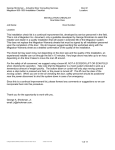
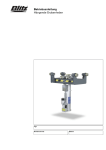

![sous-section 2 édition laser d`imprimés fiscaux [db 13k3122]](http://vs1.manualzilla.com/store/data/006408550_1-34a63c65329d358b3fbc3c8e177c82b9-150x150.png)
